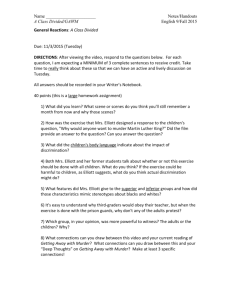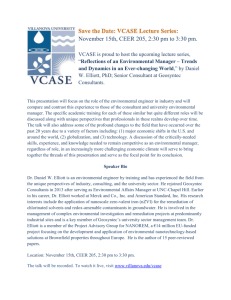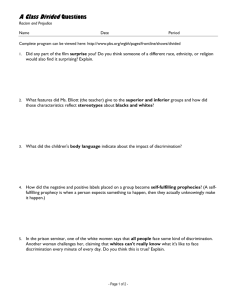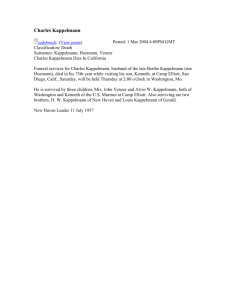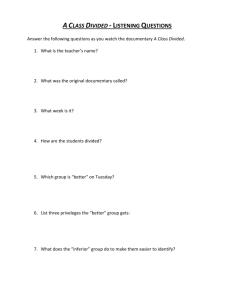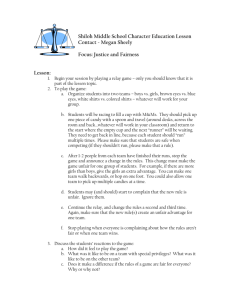Developing a Strategic Vision Plan for the Elliott Library Elliott
advertisement
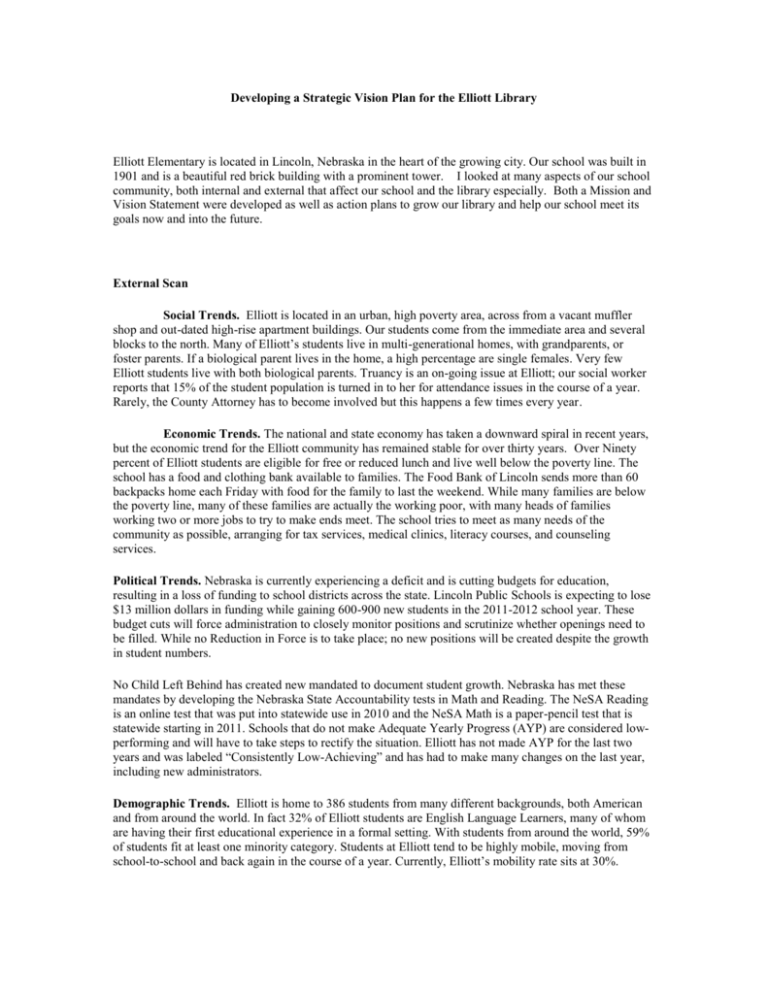
Developing a Strategic Vision Plan for the Elliott Library Elliott Elementary is located in Lincoln, Nebraska in the heart of the growing city. Our school was built in 1901 and is a beautiful red brick building with a prominent tower. I looked at many aspects of our school community, both internal and external that affect our school and the library especially. Both a Mission and Vision Statement were developed as well as action plans to grow our library and help our school meet its goals now and into the future. External Scan Social Trends. Elliott is located in an urban, high poverty area, across from a vacant muffler shop and out-dated high-rise apartment buildings. Our students come from the immediate area and several blocks to the north. Many of Elliott’s students live in multi-generational homes, with grandparents, or foster parents. If a biological parent lives in the home, a high percentage are single females. Very few Elliott students live with both biological parents. Truancy is an on-going issue at Elliott; our social worker reports that 15% of the student population is turned in to her for attendance issues in the course of a year. Rarely, the County Attorney has to become involved but this happens a few times every year. Economic Trends. The national and state economy has taken a downward spiral in recent years, but the economic trend for the Elliott community has remained stable for over thirty years. Over Ninety percent of Elliott students are eligible for free or reduced lunch and live well below the poverty line. The school has a food and clothing bank available to families. The Food Bank of Lincoln sends more than 60 backpacks home each Friday with food for the family to last the weekend. While many families are below the poverty line, many of these families are actually the working poor, with many heads of families working two or more jobs to try to make ends meet. The school tries to meet as many needs of the community as possible, arranging for tax services, medical clinics, literacy courses, and counseling services. Political Trends. Nebraska is currently experiencing a deficit and is cutting budgets for education, resulting in a loss of funding to school districts across the state. Lincoln Public Schools is expecting to lose $13 million dollars in funding while gaining 600-900 new students in the 2011-2012 school year. These budget cuts will force administration to closely monitor positions and scrutinize whether openings need to be filled. While no Reduction in Force is to take place; no new positions will be created despite the growth in student numbers. No Child Left Behind has created new mandated to document student growth. Nebraska has met these mandates by developing the Nebraska State Accountability tests in Math and Reading. The NeSA Reading is an online test that was put into statewide use in 2010 and the NeSA Math is a paper-pencil test that is statewide starting in 2011. Schools that do not make Adequate Yearly Progress (AYP) are considered lowperforming and will have to take steps to rectify the situation. Elliott has not made AYP for the last two years and was labeled “Consistently Low-Achieving” and has had to make many changes on the last year, including new administrators. Demographic Trends. Elliott is home to 386 students from many different backgrounds, both American and from around the world. In fact 32% of Elliott students are English Language Learners, many of whom are having their first educational experience in a formal setting. With students from around the world, 59% of students fit at least one minority category. Students at Elliott tend to be highly mobile, moving from school-to-school and back again in the course of a year. Currently, Elliott’s mobility rate sits at 30%. Internal Scan Assessment. Statewide standards have led to statewide testing and the Nebraska State Accountability Test (NESA) begins in Grade Three. NESA-Reading is an online test with paper-pencil ELL and SPED adaptations. This year, the NESA-Math is paper-pencil for all students and will be online in Spring 2012. The NESA-Science is being piloted this year in selected schools, to be available in the near future. Besides the statewide assessments there are quarterly District benchmark assessments in Reading, Writing, Math, and Science to assess student progress through District standards. There are also separate Curriculum assessments that are given periodically (Chapter tests, Leveled Reading Passages, Theme tests, Theme Skills tests, etc.) to assess student progress through the curriculum materials. Climate. Elliott is a small neighborhood school of 388 students with a core staff of 20 homeroom teachers, support staff (Interventionists, Specialists, ELL, and SPED) of 16 certificated teachers, 7 paraprofessionals, social workers, and counselors. The 2010-2011 school year brought new administration to Elliott along with many changes to the status quo. These changes took place due to Elliot’s failure to make AYP-a constant stressor for the staff. The stress put on staff by the pressure to make AYP has caused many senior staffers to consider retiring slightly early-many staff are nearing retirement age and have been at Elliott for twenty-five or more years. Disruptive behaviors are also a constant stress to students and staff alike. Violent outbursts and aggressive behaviors are a common occurrence among all grade levels. Many student behavior programs are in place and the police are common visitors to the school-but the cycle of behaviors continues. Standards. Nebraska has adopted state-wide standards in all areas of the curriculum in order to better meet all areas of No Child Left Behind. Lincoln Public Schools has aligned the curriculum in its schools with those of the state of Nebraska. Elliott Elementary closely follows LPS guidelines and requirements. The Elliott Library directly utilizes the American Association of School Librarians’ Standards of the 21st Century Learner in addition to Nebraska state-wide standards. Curriculum. All curriculum used at Elliott is researched and piloted at numerous buildings before being purchased for the district. The curriculum must be aligned to Nebraska state-wide standards in order to be considered for purchase. At this point in time, Elliott’s focus is on raising scores in Reading and Math. All School Improvement projects and SMART goals are focused on these two areas of focus. Organizational Analysis Strengths and Challenges of Elliott Elliott Elementary has many strengths as part of the Lincoln Public Schools District. The staff receives Professional Development Opportunities provided by the District that are diverse and high in quality. There is a vast amount of technology available to all staff members: each teacher has a personal laptop and Promethean boards, SMART boards, and ELMOs are widespread throughout the school. Training and development of skills in order to use the available technology is at the click of a mouse with the Computing Services Department. The District implemented Professional Learning Communities that are an integral part of the teaching community. Teachers work together to plan and create learning experiences for students-this has become much more focused and crucial in the 2011-2012 school year. The school has received a $6 million dollar grant that is available for the next three years as part of schoolimprovement focus. This money is to be spent to turn the school from “Persistently Low Achieving” to meeting Adequate Yearly Progress and has very set parameters. As many strengths as the school may have, it faces an equal number of challenges; for instance, School-wide behavior issues: angry behavior is often violent and aggressive towards staff. This affects morale of both staff and students this needs to be addressed without delay. Parental involvement is minimal; there is constant outreach to parents via the food and clothing bank the school maintains and many other programs to assist families-but there seems to be little improvement. Staff attitude is perceived as poor due to major changes in administration and “how things are done”. Many staff have developed a wait and see attitude rather than take changes to heart. Finally, attendance continues to be an issue. Some students have missed 30+ days of school. District policy does not allow for these students to be held backeven when well below grade level-this causes a burden on classroom teachers when truancy is a chronic problem. Strengths and Challenges of the Elliott Library The Elliott Library is a large, well-lit and cheerful space, with many tall windows and abundant natural light. The seating is varied, from cozy nooks for individuals to seating for thirty or more guests. The library is current on technology which is well-supported by Computing Services and the District Technology Coaches. The Online Card Catalog System is well-designed and well-maintained, the students are able to utilize and understand the catalog. The classroom teachers and the Librarian co-teach and coplan regularly. Collaboration between classroom and library is perceived as strong. The challenge of the Elliott Library revolves around funding and behaviors. The budget for the library is variable and is rarely the same two years in a row. This can challenge the Librarian to prioritize purchases. The other obvious challenge is that student behaviors sometimes make student scheduling in the library difficult. Supervision can be challenging when a class must evacuate a classroom or the library due to an outburst or students are running in and out of the Library without permission or teacher knowledge. Vision Statement The Elliott Elementary Library Media Center is the technological hub of the entire school and promotes information literacy for all ages. It is a place where the love of reading and life-long learning is nourished and encouraged by all members of the learning community. Gathering in the Library is considered comfortable and cozy for meetings large and small. The Elliott Library will continue to grow its collection of fiction and nonfiction books to support the curriculum needs of Elliott students and to enrich the materials available to them. Mission Statement The Elliott Elementary Library Media Center Mission is to encourage life-long learning by providing services that promote reading opportunities. Encourage and nourish a love of reading. Promote reading and information seeking opportunities and the appreciation of literature. Support and enhancement of curriculum. Encourage skills to develop information literacy so students can be independent and responsible users of ideas and information. Collaborative planning and teaching between areas of expertise will be encouraged and built upon. Promote and encourage the appropriate use of technology. Action Plans Goal One: Encourage and nourish a love of reading. Action Steps 1. 2. 3. 4. Continue the development of the collection by purchasing high interest non-fiction materials, including current event, multicultural and multi-lingual books. Continue the development of the collection in regards to meeting current curricular goals. This includes Advanced Readers and specific materials for the writing curriculum. Expand the collection with early readers and board books as the school expands to include early childhood next year. Continue the collection with current Golden Sower nominees, student requests, and other award winners (Coretta Scott King, Newberry, etc.). Schedule 1. 2. 3. 4. Current collection will be reviewed beginning May 2011. Out dated materials will be repurposed and plans made for new material purchases. Curricular needs will receive budgetary priority and will be researched to find appropriate material. Books will be ordered during the summer of 2011 to be received in the fall. They will be cyclically ordered so as not all are received at once. Space will be reorganized in the fall to create room for books. Resource Requirements 1. 2. 3. Budget for materials for upcoming school year. Personnel able to help in the processing of materials. Materials to cover books and mark them for shelving. Anticipated Outcomes 1. 2. 3. Library will better support curriculum needs. Renewed interest in the library and its resources will be apparent by an increase in check-outs. Materials will entice readers and capture the imagination, hopefully encouraging a love of reading and therefor raising reading scores. Goal Two: Promote and encourage the appropriate use of technology Action Steps 1. Identify technology needs in the library and the building. This would involve collaborating with the Technology Department as well as classroom teachers and administration. 2. Assign priorities of needs. For example, fourth graders in need of laptops for statewide writing would receive priority over IPods for second grade fluency work. 3. Purchase technology. For example, the mobile laptop carts are being over utilized at this point in time, with state-wide testing a priority. A few more carts would ease the pressure on classroom teachers and gain students time to practice skills on the computer. Schedule 1. Need identification is ongoing and documented as needs arise or become apparent. 2. Technology purchases are being put on hold until budgeting has been approved. There is no definite time or amount at this point. Resource Requirements 1. Budgetary allowance. 2. Administration approval for all purchases. 3. Adequate space and a secure storage system for all technology purchased. Anticipated Outcomes 1. Improved student test scores in Reading and Mathematics with more computer time to practice skills. 2. Students will become proficient at operating and using technology that is not available to them at home. The action plan Encourage and Nourish a love of Reading will be a priority for the Elliott Elementary Library as a budget has been set aside for this use. The technology is very much needed, but has been moved to the back burner in this time of budget cuts. There is also a grant available that might enable the purchase of technology through other sources. This ensures that books are the number one focus of purchasing for the upcoming school year.
